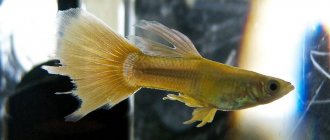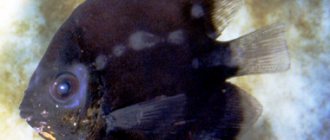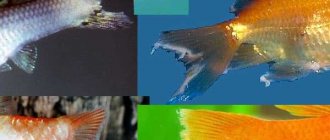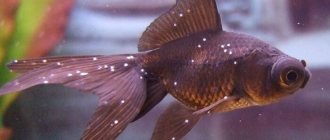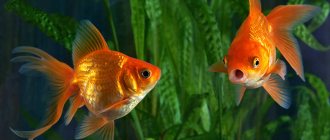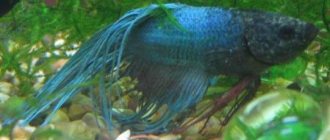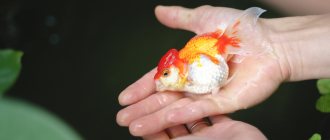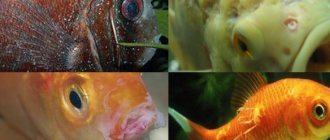There are quite a lot of fungal diseases that affect aquarium fish, but one of the most common of them is considered dermatomycosis or saprolegnia. The disease primarily affects young organisms, actively developing in gills And fins fish Also, dermatomycosis can develop on the skin of aquarium pets, due to which the disease can be diagnosed. If you ignore the symptoms, saprolegnia will be fatal. More details about how to treat saprolegnia in aquarium fish will be discussed in this article.
Saprolegnia (dermatomycosis) in aquarium fish
Description of the disease
Saprolegnia or, as it is also called, dermatomycosis is a mycotic disease of a fungal nature. Mostly freshwater inhabitants suffer from the disease. Phycomycetes fungi act as the causative agent of the pathology. During development, fungal spores rupture and spread throughout the body of the infected fish. It is worth noting that saprolegnia fungi are capable of reproducing sexually, so they develop quite quickly.
The disease primarily affects freshwater fish.
Note! Saprolegnia, despite its fungal origin, is not dangerous to the human body.
Video
Saprolegniosis dermatomycosis
Dermatomycosis, or saprolegniosis - when first detected, the carrier went on a trip!
Pond at the dacha. Diseases of pond fish. Saprolegniosis of fish. Growing fish. Your own pond. Pond on the site.
Saprolegnia
Reasons for the development of saprolegniosis
Various factors can provoke the development of dermatomycosis, for example, injury during transportation, inconsistency in the salt composition of the water in the aquarium, a violation of the gas regime, or simple starvation of the fish. Saprolegnia often develops against the background of other diseases, including branchiomycosis , pseudomonosis, aeromonosis, and so on. Pathology affects the body of aquarium fish, regardless of the time of year, if favorable conditions for this appear in the aquarium or reservoir.
What does saprolegniosis look like?
Important! If you follow all the conditions, regularly change the water and feed the fish, they will not become infected with saprolegnia. This is impossible even in cases where there are pathogens in the aquarium.
Rubella of carp
Rubella (aeromonosis) of carp is one of the most common and dangerous diseases of carp and carp. In addition to these species, rubella is observed in crucian carp, tench, grass carp and some other species, but these cases are usually rare.
Rubella is a contagious disease, which, according to some researchers, is caused by a virus, while others believe it is caused by bacteria. There is objective evidence in favor of both hypotheses. Apparently, the term “rubella” covers several diseases with similar symptoms. Based on research conducted by the All-Union Institute of Experimental Veterinary Medicine, it was proposed to distinguish three independent diseases: aeromonosis caused by the bacteria Aeromonas punctata, pseudomonosis caused by bacteria of the genus Pseudomonas, and spring viral disease caused by the Rabdovirus cyprini virus (Vasilkov et al., 1978).
Rubella usually occurs in the spring or first half of summer. Sometimes the disease occurs in winter. Most often, two- and three-year-old carp are affected. The disease can cause massive waste. In the acute course of the disease, hemorrhages on the surface of the body, dropsy, bulging eyes, and ruffling of scales are noted. In the subacute course of the disease, the signs described above are supplemented by the formation of ulcers that have a whitish or reddish rim. The chronic form of rubella is most often observed in the second half of summer and is accompanied by the formation of ulcers on the skin and fins. The diagnosis can only be made by a specialist based on a set of studies.
To treat fish, drugs such as chloramphenicol, tetracycline, biomycin, methylene blue and a number of other drugs are used. In recent years, the use of probiotics has come into practice. Treatment is prescribed only by an ichthyopathologist, taking into account many factors relating to a particular body of water. Inappropriate use of antibiotics can cause negative results.
The only reliable method of rehabilitating a farm from rubella is summering, during which the ponds are drained, treated with disinfectants, and fish of all age groups are sold to the retail chain or disposed of. If sick fish live in a farm's water supply, it is almost impossible to improve its health.
Characteristic symptoms
The first thing you notice after an aquarium fish is infected with a fungal disease is a white coating that affects the fins or the entire body. But after a couple of days, the slight plaque gradually turns into thick mold. In the place of its development, lesions appear: traces of blood appear, and the scales rise slightly. If the disease affects the gills, then during its development the petals turn pale and begin to die.
Symptoms of the disease
In addition to ulcerative formations and traces of mold, other signs may appear on the body of an infected fish:
- exhaustion of the body (the fish becomes very thin);
- clouding of the pupil;
- the appearance of an eyesore;
- decreased activity;
- deterioration of appetite or complete loss of it;
- gluing of fin rays (gradually they delaminate or break).
Infected fish become quite lethargic. In such an exhausted state, she does not live long, so if proper treatment is not started, the pet will die within a few days.
Infected fish become quite lethargic
Diplostomatosis
Diplostomatosis is an invasive fish disease caused by the larvae of digenetic flukes from the family Diplostomatidae, which parasitize the eyes of fish. Diplostomatosis is widespread among fish living in natural bodies of water. Juveniles and adult fish are sick.
Characteristic signs of the disease: clouding of the lens, formation of a cataract, blindness. Sometimes bulging eyes are observed. The membranes of the eyes become inflamed, impeding blood circulation, as a result the lens is destroyed, death and ulceration of the corneal tissue occurs, and the lens falls out. Saprolegnia fungi colonize the affected areas of the eye. Having lost vision, the fish does not take food well and loses weight; juveniles are stunted.
The causative agent of diplostomiasis develops with the help of two intermediate hosts: the first is a pond mollusk, the second is a fish. The main host is a fish-eating bird.
Treatment of ringworm
To reduce fungal activity, it is necessary to raise the temperature in the aquarium to the recommended 26°C. This is how therapy for dermatomycosis in fish should begin, regardless of the drug chosen. Then medications are used that effectively fight the fungal disease. The most commonly used products are malachite greens, copper sulfate or ordinary salt. Let's consider each of the drugs separately.
Malachite green
It is necessary to prepare a solution at the rate of 1 ml of medicine per 100 liters of water. The infected fish should remain in the prepared solution for 40-60 minutes, after which it should be placed in clean water. If necessary, the procedure can be repeated, but not earlier than after 5 days.
Malachite green
Copper sulfate
A copper sulfate bath does an excellent job of treating fungal infections on the body of an infected fish. To prepare it, you need to mix the medicine with water at the rate of 1 ml of copper sulfate per 10 liters of water. Place the fish in the prepared solution for 30 minutes. Repeat the course of therapy after 7-10 days.
Copper sulfate
Methylene blue
Another effective remedy for dermatomycosis. To prepare a therapeutic bath, add 50 ml of methylene blue . The aquarium pet must stay in the solution for 12 hours. This time is enough to destroy the fungus.
Methylene blue
Salt
A simple but at the same time effective remedy for the treatment of saprolegniosis. It is necessary to prepare a 5% solution of table salt and place the fish there. After 5 minutes, it should be placed in an aquarium with clean water. If necessary, the procedure can be repeated after a week.
Salt
Note! Plants, soil and all decorations of the aquarium where the infected fish lived must be disinfected with a manganese solution. This is necessary to destroy all spores and dirt.
Etiology pathogenesis
Saprolegniosis is caused by fungi from the oomycete class, the order Saprolegniales, and belonging to several genera: Achlya, Aphonomyces, Dictyuchus, Leptolegnia, Saprolegnia, etc. The most common and pathogenic are the following species: Ach. flagellata, Aph. laevis, D. monosporus, S. ferax, S. mixa, S. parasitica, Achlia flagellata, capable of transitioning from saprophy to necrophy. Molds are branched hyphae without septa. Hyphae can be either thin, weakly branching, no more than 20 microns wide, or wider, branching. Hyphae consist of a membrane and cytoplasm containing numerous nuclei. Saprolegnia fungi are characterized by asexual and sexual methods of reproduction. The organs of asexual reproduction (zoosporangia) are located at the ends of the hyphae. They are filled with numerous zoospores, which have 2 flagella for movement in water. Mature zoospores enter the water, germinate and give rise to new hyphae. With the sexual method of reproduction, male (antheridia) and female (oogonia) genital organs are formed on short processes of hyphae. Oocytes develop in oogonia. The antheridia grow, approach the oogonia and, through special pores in their shell, release a process into the oogonia through which the antheridium nucleus flows into the egg. As a result of the fusion of male and female nuclei, a zygote is formed, which is covered with a membrane and turns into an oospore. After a period of dormancy, the oospore in the water germinates and forms a new hypha. The structure of oogonia and antheridia is an important systematic feature. Optimal temperatures for the growth and reproduction of mold fungi are 12-20 °C. Saprolegniosis manifests itself in the form of cotton wool-like growth of the fungus on various parts of the body surface, fins, gills, and less often on internal organs.
Editorial: Asterophisus batraus
Drug therapy
Not only baths help with saprolegnia. Pharmacy drugs cope well with this disease. Below are the most effective of them.
Table. Preparations for saprolegniosis in fish.
| Name of the drug, photo | Description |
| Antipar | A veterinary medicinal product with antifungal and antibacterial properties. Produced as a blue-green liquid. Anti-steam is used in the treatment of invasive diseases in aquarium fish. |
| Bicillin-5 | Antibacterial drug in the form of powder for injection. Prescribed for the treatment of various diseases of infectious or fungal etiology. |
| Rivanol | An antiseptic veterinary product that contains ethacredin lactate. Has antimicrobial and antibacterial properties. |
| Streptocide | An effective drug that has antibacterial and antiseptic effects. Available in powder form. It is used in the treatment of various pathologies, including saprolegniosis. |
| Sulfadiazine | Another antibacterial drug that has an antimicrobial effect. The active substances are sulfadiazine and trimethoprim. |
Before starting therapy, you must read the instructions from the manufacturer so as not to worsen the condition of the infected fish. It is important to follow the dosage, otherwise potent drugs can harm a weakened body.
Cotton disease
Diagnosis of common diseases.
It is not always easy to diagnose the various diseases that can develop in tropical fish, especially in their early stages. The diagnosis may be further complicated by the fact that more than one infectious agent is responsible for the visible symptoms. For example, when a fish develops a “white spot,” bacteria and fungi can gain access to the area of the body that was originally infected by parasites, confusing the diagnostic picture.
The table will help diagnose the most common symptoms affecting freshwater species and guide appropriate treatments. In the table below, identify the part of the fish organ that appears to be affected. Next, look for disease symptoms that most closely match the fish's indications. Note the numbers associated with the appropriate characters and refer to pages 57 and 58 for a more complete description of possible conditions and their treatment.
How to prevent the development of saprolegniosis
To prevent the development of ringworm in aquarium fish, it is important to prevent damage to their mucous membrane . Therefore, during transportation it is necessary to ensure that the fish cannot harm themselves or are not subjected to severe stress. It is also important to use a UV water clarifier. This will reduce the likelihood of developing pathology.
Prevention of saprolegniosis
Speaking of breeding fish, to prevent damage to the eggs, feeding them with tubifex is strictly not recommended. Experts also advise using an iodine solution to protect fertilized eggs from damage by Saprolegnia.
Hexamitosis, or hole disease
Fin rot in aquarium fish
Why do fish die in an aquarium?
White small worms on the glass of an aquarium
Cavious
Cavious disease is a helminthic disease of carp, carp and their hybrids, black and white carp, characterized by intestinal damage. Caused by the cestode Khawia sinensis from the family. Caryophyllaidae.
The disease is recorded in all carp breeding zones. All age groups of fish are susceptible to the disease, but mainly fingerlings and two-year-old carp in the spring and summer. In nature, the pathogen persists in fish during the winter. Helminths are localized in the intestines and remain viable, and in the spring they begin to produce eggs. Cavia larvae remain in the body of intermediate hosts - oligochaetes, which also overwinter in water bodies. in the lower layer of soil. In the spring, when the ponds are filled with water, oligochaetes become active and rise to the top layer of soil. Fish, feeding at the bottom of reservoirs, eat infested oligochaetes and become infected with caviosis.
Symptoms Sick fish are inactive and their mobility is limited. they stay more in shallow water near the shores of the pond, their skin is dull. Nutritional status decreases and emaciation is noted. The gills and mucous membranes are anemic, there is swelling of the abdomen and redness of the anus.

